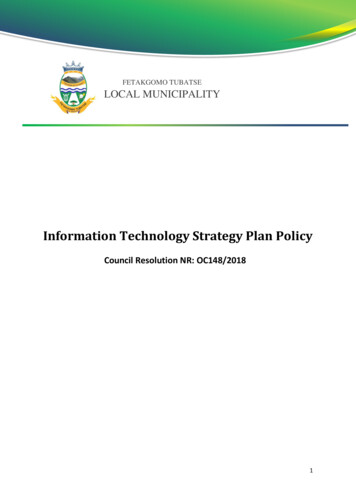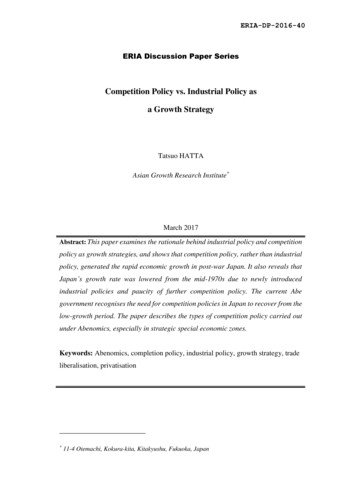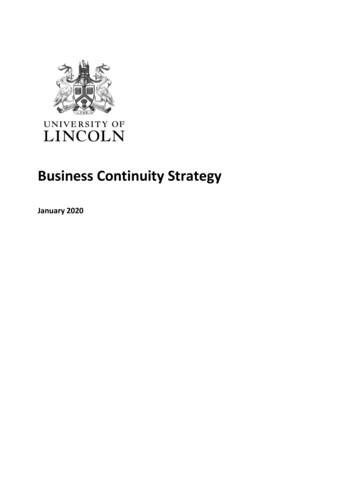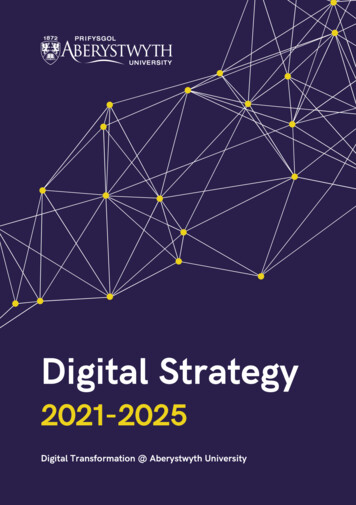
Transcription
FETAKGOMO TUBATSELOCAL MUNICIPALITYInformation Technology Strategy Plan PolicyCouncil Resolution NR: OC148/20181
Table of Contents1.Executive Summary. 31.1. Current state of Information Systems . 31.2. Information Management . 31.3. ICT Management . 41.4. Strategic Management . 41.5. Strategic Business Architecture . 41.6. Environmental Challenges . 41.7. Municipal Challenges . 51.8. Improvement Opportunities . 51.9. Expected Benefits . 61.10. IT Strategy Plan Initiatives . 62. Context and approach . 92.1. Information Technology Strategic Planning. 92.2. Municipal Context . 132.3. Strategic Imperatives . 142.4. Funding . 162.5. Structures . 162.6. Information Management . 162.7. Environmental Challenges . 232.8. Municipal Challenges . 233. External Analysis. 243.1. National & Provincial, District standards & initiatives . 243.2. Integrated Development Plan (IDP) . 243.3. Technology Trends . 254. ICT Architectures. 264.1. Information and Communication Technologies (ICT) . 274.2. Current state of ICT’s in Fetakgomo – Greater Tubatse Municipality . 274.3. Information Systems . 284.4. ICT Management . 284.5. Future Architectures . 295. IT Strategy Plan. 325.1. Public Services . 33Contact Centre. 36Tourism Development . 36Library services . 365.2. Platform Services . 365.3. Infrastructure Services . 385.4. IT Strategy Plan Initiatives . 395.5. Prioritization . 405.6. Implementation Plan . 415.7. Benefits . 425.8.Strategy Plan Review . . 432
Definitions, Acronyms and Abbreviations . 431. Executive SummaryMunicipalities are under increasing pressure to show visible improvements in service delivery.These pressures create additional strain on the system of local government. In order to functioneffectively under these strains, accurate and effective communication, and information is requiredbetween the system and its constituents.The traditional focus of municipalities on technology and financial information is no longer sufficientto manage the ever-increasing relationships, management information, reporting, legislative, andcommunication requirements.The lack of timely, accurate information leads to sub-optimal decision-making and a possible slideinto a ‘fool’s paradise’, and ultimate anarchy.In the Analogy of the Grotto, Brain talks about the future belong to the takers, not the securityseekers. The more you seek security, the less of it you will have and the more you pursueopportunity, the more security you will achieve. People don't want to face the truth or the light,unless the market imposes that task on them, unless they virtually have no choice but to seekfeedback and do something about it regularly.1.1. Current state of Information SystemsIn order to provide for the required information, Municipality has implemented a number of paperbased and electronic information systems.The most successful of these information systems is the implementation of the Financial System,which is capable of providing financial department of the Fetakgomo Tubatse with access to makeelectronically all financial requirement needs of the Municipality.The municipality has also succeeded in maintaining a stable financial system (Venus\Solar andPayday) that is capable of meeting their required financial, legislative and reporting needs.1.2. Information ManagementDespite these successes, the system breaks down in a number of places. Key areas are in feedbackto the public on service delivery, flow of information between council and officials, and flow ofinformation to staff not provided with access to computers.Furthermore, reports requested by other agencies (national, provincial) are sometimes beingdelayed, or provided on time.“Once you get information, you tend to use it. When you get enough people with information, you3
raise the consciousness and unleash energies. The higher the consciousness, the more the social,national and political will develop.”1.3. ICT ManagementThere is commitment from municipality to ensure that ICT management becomes one of itspriorities, with the insufficient fund allocated to ICT in the municipal’s IDP process, which leads topoor/limited management of ICT assets such as hardware, software etc.1.4. Strategic ManagementKey to the effective functioning of the municipality is an alignment between the strategicimperatives, and the operational objectives. This link appears to be missing, resulting in aperception of poor service delivery/and or capabilities.Furthermore, departments appear to operate in vertical silo’s, with limited interaction between them.This severely affects the municipalities’ ability to respond efficiently to service requests.It was further found that the Integrated Development Plan (IDP) is minimally integrated in themunicipality’s operations for planning, budgeting, measurement and implementation purposes.Furthermore, diverse services are required by the public in all wards, but only some Financial(Payment) and Engineering service are provided.1.5. Strategic Business ArchitectureThe Constitution establishes local government as a distinctive sphere of government,interdependent and interrelated with national and provincial spheres of government.There is fundamental agreement in the country on a vision of democratic and developmental localgovernment in which municipalities fulfill their constitutional obligations.These are determined to ensure sustainable, effective and efficient municipal services; promotesocial and economic development; encourage a safe and healthy environment and working withcommunities in creating environments and human settlements in which all our people can leaduplifted and dignified lives.This assessment identifies the objectives of Fetakgomo – Greater Tubatse municipality accordingto the constitution; the vision, mission, purpose, and values for Fetakgomo – Greater Tubatsemunicipality, and highlights the municipal context, strategic imperatives, funding, and structures.1.6. Environmental ChallengesIn implementing this vision, the INFORMATION TECHNOLOGY STRATEGY PLAN current stateassessment has determined a number of environmental challenges that may hinder theachievement of these ideals.As highlighted before, there is increasing pressure on service delivery that is exacerbated by a lackof resources (Computers) to perform as before. Delivery is further throttled by having to comply withincreasing regulation, and limited use of own initiative.4
In the municipality, there is a perception of limited competency. This results in a lack of trust, poordecision making ability, lack of responsibility, and the emergence of a blame culture. It is alsoevident that authority is not delegated with responsibilities.Lastly, some staff exhibits a general lack of motivation or purpose (why), and appears to feelhelpless to influence system, threatened by BBEE requirements, and/or are biding time forretirement/end of their contract.1.7. Municipal ChallengesIn addition to the previous challenges, there appears to be no clear strategy on service delivery.With increasing demands from communities, and decreasing ability to deliver services, themunicipality will require the ability to match resources to service needs, and say ‘no’ to services thatcannot be delivered.This situation is further worsened by poor communication with the citizen, between council andmunicipality, between business units, and in business units.The system also appears to be inflexible, and does not adapt well to change. Strict compliance withrules and regulations lead to limited innovation and initiative. There also appears a strong influenceof the trade unions on employees.and that ICT is under-funded (less than 10% of the total budged).1.8. Improvement OpportunitiesA preliminary assessment has identified the following improvement opportunities.ICT management requires dedicated attention. It is however feasible for the municipality to createa dedicated post for ICT management. It is therefore not practice that unit managers takeresponsibility for their own ICT management needs, and that an ICT steering committee should beoperative to coordinate such activities, and represent the ICT requirements at the executive mayoralcommittee.It is also vital that the municipality clarify focus areas (strategy) of municipality, and theroles/relationship between the council and the municipality.Furthermore, to enhance whole system collaboration, it is recommended that Fetakgomo – GreaterTubatse municipality:1. Hold regular formal/informal meetings between council and officials, and amongstdepartments, and with outlying offices2. Make council and management minutes available to all staff (electronically & on paper)3. To improve interaction with communities, it is recommended that Fetakgomo – GreaterTubatse:4. Implement an integrated service counter (e-Government services)5. Use Venus system effectively as a basis for integrated service delivery platform.6. Implement a call center integrated with Venus system for emergency services andservice requests/complaints5
It is also prudent for the municipality to align itself with the LG-Net initiative, as it can bebeneficial to aid the municipality in service delivery information.It should also be noted that funding for the IT STRATEGY PLAN initiatives identified in thisdocument should come from capital expenditure or special project funding.1.9. Expected BenefitsBy implementing the IT Strategy Plan, Fetakgomo – Greater Tubatse municipality should benefitthrough improved communication, aligning their ICT with the municipality’ strategies, and by puttingpeople first.1.10.IT Strategy Plan InitiativesAs part of the IT Strategy Plan, and the future state development, a number of ICT initiatives havebeen identified jointly with the municipality. These initiatives, together with the managementinitiatives, shall be prioritized by the ICT steering committee, and further funding/budgets sought orallocated. Following is a listing of the key IT Strategy Plan initiatives:1.10.1.Strategic ManagementStrategic management defines how the municipality manages its key resources in enablingservice delivery:1. Decide on role of outlying offices– The satellite offices in Mohlaletse, Atok, Mabopo,Mapodile, Steelpoort, Ohrigstad, and Praktiseer and the Staykraal, Pelangwe, Sekodibeng andMphanama community halls as well as Fetakgomo – Greater Tubatse libraries should beconsidered to be converted into a full service point by deploying a full ICT infrastructure to them.2. Clarify key development and service delivery priorities – based on the IDP process,“It is essential to spend the limited council (municipal) resources on the key developmentpriorities of the local community”.1.10.2.E-GovernanceE-Governance defines how the municipality does ICT planning and management in themunicipality. The following section outlines these ICT management and planning initiativesidentified as part of the e-governance recommendations.1. ICT Steering committee – ICT management require dedicated attention in themunicipality. Lack of budget and dedicated staff indicate a joint responsibility amongst seniormanagers and system owners. The Municipal Manager or Section 57 Manager appointed byaccounting officer shall represent the ICT Steering committee at EMC. The manager IT &personnel will act as the secretariat, coordinating meetings, minutes, and contact person for allinitiatives.6
2.Prioritize IT STRATEGY PLAN initiatives - The ICT Steering committee needs toprioritize these IT STRATEGY PLAN initiatives, based on available funding and capability tosource funding and vendors. These initiatives can be prioritized according to the scoringframework provided.3.Develop a transparent ICT procurement process – To prevent ICT’s from beingimplemented without due consideration for the organizational and functional needs, atransparent process should be implemented based on detailed system requirements.4.IT STRATEGY PLAN Initiatives funding to come from CAPEX or specialproject funding – Funding for IT STRATEGY PLAN initiatives, are over-and-above thecapital required for the normal operation of the municipality. Funding should be provided bybudgeting for capital expenditure items, and by applying for donor grants.1.10.3.E-Government ServicesE-Government services are effectively normal services provided through e-channels such asinternet/email, telephones, and computers. Following are the key e-Government services thatFetakgomo – Greater Tubatse municipality should implement as part of their INFORMATIONTECHNOLOGY STRATEGY PLAN.1.Train all managers in budgeting and financial basics – in order to improve theadoption of the financial system in the municipality, all managers should do their departments’budget, and financial analysis on Venus module that deals with budgeting. This may requireadditional training.2.Implement IDP Information Management System - The municipality is required toestablish and manage an internal IDP system. The system should be capable of planning,prioritizing, and tracking progress on IDP initiatives. This should be linked to budgeting andproject management systems in order to evaluate progress and performance management.3.Implement and Roll out Document Management System (DMS) toeveryone in the municipality – Information from DMS should be made available inpaper format, or by providing shared PC’s for staff that do not have their own. Minutes, Bylaws,and public notices should be reproduced free of charge from DMS, and made available to thepublic.4.Deploy services to remote areas by using ICT’s –in order to provide the staff atthese offices with the tools to answer all types of queries, not just financial ones etc.5. Implement a central Information contact center- Implement a central contact center integratedwith DMS for emergency services and service requests/complaints. This should allow for allpublic calls, information, service request, enquiries, emergencies etc. to be logged and handled.This does not mean that calls are just logged and forwarded. Agents should be able to answer7
all reasonable municipal queries as a first line contact Center. More complicated requestsshould be forwarded to the relevant people. All requests should be logged, and allocated inDMS.1.10.4.Platform ServicesThe following section defines the platform services on which the provisioning of egovernment services is dependent.a.Application Platform (Software) - Ensure continued support for Venus\Solar andPayday System.b.Implement Citrix terminal server for resource intensive applications – allresource intensive applications for remote stations, DMS & internet should be deployed viaCitrix. Develop and implement desktop & Server standards - The servers are Windows Server2008 R2. This ensures easier support and updates. Servers should be upgraded to the latestOS.ICT Infrastructure ServicesThe following ICT improvement opportunities have been identified:1. Consolidate Servers – Once the servers have been upgraded, all applicationsshould be consolidated, and the number of servers reduced. Vendor applications canall be run off the same servers. The municipalities’ IT service provider should be ableto remotely manage and configure these servers.2.Upgrade Server Room Infrastructure - The computer room should ideally adhere tobest-practice standards and have amongst others access control, temperature control, raisedflooring, static protection etc.3.Implement ADSL for Internet Access - The current bandwidth for externalconnectivity is extremely slow and should be upgraded to accommodate email and Internetconnectivity and also prepaid updates. An uncapped ADSL solution should be investigated orboth of the above proposed solutions.1.10.5.ConclusionIn order to address the strategic importance of ICT in the Fetakgomo – Greater Tubatsemunicipality, and change the system to accommodate these new needs, individuals in theorganization will be required to change their paradigms.Although this is not the purpose of an IT STRATEGY PLAN, it is hoped that the techniques andframeworks established during the development of the IT STRATEGY PLAN will aid themunicipality in providing a platform for such change.8
2. Context and approachThe modern and different needs of municipalities require new and more innovative responses frominformation systems, information technology as well as information management system. Therefore,when municipality begins to deliver these systems that will enable more effective functioning, itcharacterizes the well-being of municipality in the information age. This however, places greateremphasis on municipality to accommodate the rapid technological surge. Corollary, we findinformation technology as a major catalyst for creating change. We witness every day, the emergenceof new challenges and advantages that it brings to the business environment, both in public andprivate sectors.The focus of ICT in municipalities has traditional been on technology and infrastructure.Software is purchased to automate manual processes. The most important automation hasbeen financial accounting, driven by a need for more detailed data on budgeting andexpenditures.“Financial accounting only tells you about things that are measurable.it does not deal withpeople problems and challenges. Using financial accounting to deal with people problems islike playing rugby with a volley ball: the tool is not suited to the sport.” It focuses almostexclusively on acute problems and surface effects: revenues, costs, etc. This can be likenedto keeping score in a soccer game. The score shows who won or lost, but not how the gamewas played or the rules of the game.This raises a challenge for the municipality in trying to understand the demands of servicedelivery in the context of a government system, the flows or blockages of information, andcollaborating and participating with various stakeholders.“A (municipality) is an ecological system (made up of people working in a community), and theinformation systems should deal with the whole environment to help executives understandwhat’s going on.” This requires of all councilors and officials to build environment whereinformation systems and information technology is not only aligned to the broader processes ofservice delivery, but to deal more effectively with people (employees citizens, funders, othergoverningbodies). “Until an executive understands what’s going on, his judgments anddecisions will be flawed, distorted, incomplete or inaccurate. People believe that they want tobelieve, and what is strongly desired is easily believed”. To achieve this requires commitmentand synergy in effort.2.1.Information Technology Strategic PlanningIn order to understand the human, information, and functional needs of the municipality, anapproach called Information Technology Strategy planning is used. The overall project objectiveof the IT STRATEGIC PLAN is to provide an appropriate and stable platform to:1. Strengthen, effectively manage and implement the Municipality’s IDP process.9
2. Assist with the co-ordination and future planning of the functions, particularly servicedelivery, of the Municipality.3. Improve revenue collection.4. Improve the effective management of the municipality’s assets.5. Improved utilization of the Municipality’s human resources.6. Facilitate accurate and timeous statistical and performance management reporting forall levels within the municipality and also reporting required for customers andexternal stakeholders (e.g. National and Provincial government).7. Facilitate improved access to electronic based data resources and communicationsystems.8. More importantly to reduce the costs of delivering of delivering and managingservices delivery using technology.2.1.1. Purpose of IT STRATEGYThe IT STRATEGY is required to provide a long-term vision for information systems andinformation technology in Fetakgomo – Greater Tubatse municipality that is based on themunicipalities’ strategies and vision, human and information needs, and regulatorycompliance. The IT STRATEGY presents a framework and methodology to providemanagement with the facilities to help them achieve their overall strategic objectives, plan,review, and control information systems projects. The IT STRATEGY also contains specificelements to give guidance on what is required and how it will be done, the use of explicit toolsto support and automate the process, and how to manage and sustain the quality of theresults.The purpose of the IT Strategic Plan is therefore to:1. Ensure that information systems strategic planning is consistent, aligned andfully integrated within the broader strategic business planning processes ofthe Municipality, the District, and the Province and as a whole at the threelevels of business (strategic, tactical and operational).2. Introduce and implement the concept of an integrated public counter (eGovernment services) in Fetakgomo – Greater Tubatse and theimplementation of e-Governance in the near future.2.1.2. ExpectationsThe following expectations and needs were identified:The IT STRATEGIC Plan must;1. Provide a Comprehensive, Prioritized Plan for Information Systems,incorporating systems support2. Support achievement of strategic objectives thereby ensuring alignment andcoordination with information systems10
a. Integrated Information Systemsb. Achieve circuit goalsc.Ensure correct delivery structuresd. Access to Timely Informatione. Be User Friendly, Accessible, Accurate, Holistic, and Flexible.2.1.3. ObjectivesAn enterprise overview of the municipality’s business processes, and how the municipality’sInformation Technology (IT) environment interfaces with the business processes to contributetowards the following.1.Implementation of the Council’s IDP process.2.Improvement in the quality and cost effectiveness of service delivery3.Improved revenue collection.4.Improved management of the municipality’s assets.5.Improved utilization of the Municipality’s human resources.6.Facilitate the process of delivering effective and efficient service.2.1.4. OutputA fully functional IT Strategy Plan developed that assist the municipality in delivering servicein a more effective and efficient manner.2.1.5. BeneficiariesThe direct beneficiaries of the projects identified in the IT STRATEGY PLAN will be themunicipality and its employees/departments, who will be capacitated to manage the municipalsystems. The community will benefit indirectly as they should receive more efficient andeffective service delivery and improved financial and technical customer information facilities.2.1.6. Key StakeholdersThe IT STRATEGY PLAN is based on review of acts, policies, guidelines, documents of theFetakgomo – Greater Tubatse municipality and interaction with some key stakeholders.2.1.7. Strategic Business ArchitectureThis phase is aimed at agreeing on a general understanding of the strategic activities of themunicipality, and how it relates to information and communication technology (ICT)requirements in general. The following section will review the municipalities’ key strategies,mission, purpose, values, and challenges in order to provide direction, and a foundation forthe IT Strategy Plan.11
2.1.8. Objectives of local governmentAccording to the Constitution, the objectives of local government are:1. To provide democratic and accountable government for local communities;2. To ensure the provision of services to communities in a sustainable manner;3. To promote social and economic development;4. To promote a safe and healthy environment; and5. To encourage the involvement of communities and community organizationsin the matters of local government.A municipality must strive, within its financial and administrative capacity, to achieve theobjects set out in subsection.2.1.9. Developmental duties of municipalitiesA municipality must:1. Structure and manage its administration, and budgeting and planningprocesses to give priority to the basic needs of the community, and topromote the social and economic development of the community; and2. Participate in national and provincial development programmes.2.1.10. Municipalities in co-operative governmentThe national government and provincial governments, by legislative and othermeasures, must support and strengthen the capacity of municipalities to manage theirown affairs, to exercise their powers and to perform their functions.Draft national or provincial legislation that affects the status, institutions, powers orfunctions of local government must be published for public comment before it isintroduced in Parliament or a provincial legislature, in a manner that allows organizedlocal government, municipalities and other interested persons an opportunity to makerepresentations with regard to the draft legislation.2.1.11. MandateLocal municipalities are mandated to:1. Pass by-laws - local laws and regulations about any of the functions they areresponsible for. By-laws may not go against any national laws.2. Approve budgets and development plans - every year a municipal budget mustbe passed that sets down how money will be raised and spent. The municipalitymust also approve the Integrated Development Plan (IDP).3. Impose rates and other taxes, for example property tax.12
4. Charge service fees for using municipal services like water, electricity, libraries,and so on.5. Impose fines for people who break municipal by-laws, for example traffic fines orlittering.6. Borrow money - the council can take a loan for a development or other projectand use municipal assets as surety.2.1.12. ResponsibilitiesLocal municipalities are responsible for the following services:1. Electricity delivery2. Water for household use ( although in our case is provided for by the Districtmunicipality)3. Sewerage and sanitation4. Storm water systems5. Refuse removal6. Fire fighting services( District )7. Municipal health services8. Decisions around land use ( Administered by the Tribal Authority)9. Local roads10. Local public transport11. Stre
In implementing this vision, the INFORMATION TECHNOLOGY STRATEGY PLAN current state assessment has determined a number of environmental challenges that may hinder the achievement of these ideals. . document should come from capital expenditure or special project funding. 1.9. Expected Benefits By implementing the IT Strategy Plan, Fetakgomo .










